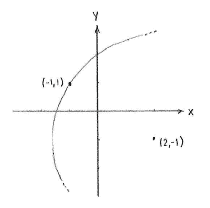Lösung 4.1:5b
Aus Online Mathematik Brückenkurs 1
(Unterschied zwischen Versionen)
K (hat „Solution 4.1:5b“ nach „Lösung 4.1:5b“ verschoben: Robot: moved page) |
|||
| Zeile 1: | Zeile 1: | ||
| - | + | Nachdem der Punkt (-1,1) auf den Kreis liegen soll, muss der Radius des kreises der Abstand zwischen den Punkten (-1,1) und (2,-1) sein. Wir berechnen zuerst diesen Abstand, | |
{{Abgesetzte Formel||<math>\begin{align} | {{Abgesetzte Formel||<math>\begin{align} | ||
| Zeile 5: | Zeile 5: | ||
\end{align}</math>}} | \end{align}</math>}} | ||
| - | + | Jetzt wissen wir den Mittelpunkt und den Radius des Kreises, und können die Gleichung erhalten, | |
{{Abgesetzte Formel||<math>(x-2)^2 + (y-(-1))^2 = (\sqrt{13})^{2}</math>}} | {{Abgesetzte Formel||<math>(x-2)^2 + (y-(-1))^2 = (\sqrt{13})^{2}</math>}} | ||
| - | + | oder | |
{{Abgesetzte Formel||<math>(x-2)^{2} + (y+1)^2 = 13\,\textrm{.}</math>}} | {{Abgesetzte Formel||<math>(x-2)^{2} + (y+1)^2 = 13\,\textrm{.}</math>}} | ||
| Zeile 16: | Zeile 16: | ||
[[Image:4_1_5_b-1(2).gif|center]] | [[Image:4_1_5_b-1(2).gif|center]] | ||
| - | + | Hinweis: Ein Kreis mit den Mittelpunkt (''a'',''b'') und Radius ''r'' hat die Gleichung | |
| - | + | ||
{{Abgesetzte Formel||<math>(x-a)^2 + (y-b)^2 = r^2\,\textrm{.}</math>}} | {{Abgesetzte Formel||<math>(x-a)^2 + (y-b)^2 = r^2\,\textrm{.}</math>}} | ||
Version vom 17:24, 2. Apr. 2009
Nachdem der Punkt (-1,1) auf den Kreis liegen soll, muss der Radius des kreises der Abstand zwischen den Punkten (-1,1) und (2,-1) sein. Wir berechnen zuerst diesen Abstand,
| \displaystyle \begin{align}
r &= \sqrt{(2-(-1))^2+(-1-1)^2} = \sqrt{3^2+(-2)^2} = \sqrt{9+4} = \sqrt{13}\,\textrm{.} \end{align} |
Jetzt wissen wir den Mittelpunkt und den Radius des Kreises, und können die Gleichung erhalten,
| \displaystyle (x-2)^2 + (y-(-1))^2 = (\sqrt{13})^{2} |
oder
| \displaystyle (x-2)^{2} + (y+1)^2 = 13\,\textrm{.} |
Hinweis: Ein Kreis mit den Mittelpunkt (a,b) und Radius r hat die Gleichung
| \displaystyle (x-a)^2 + (y-b)^2 = r^2\,\textrm{.} |

